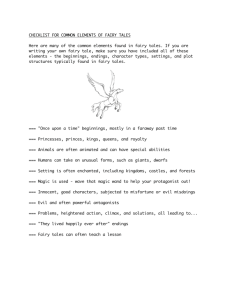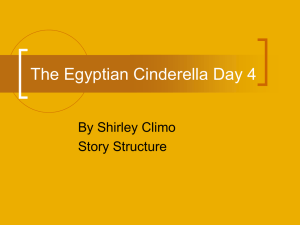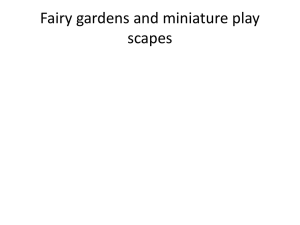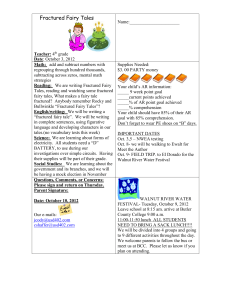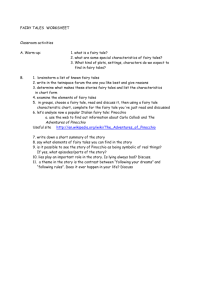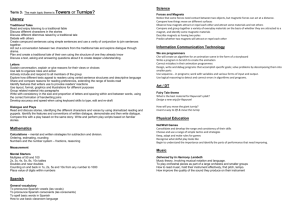Fairy Tale Unit Plan - jrex2
advertisement
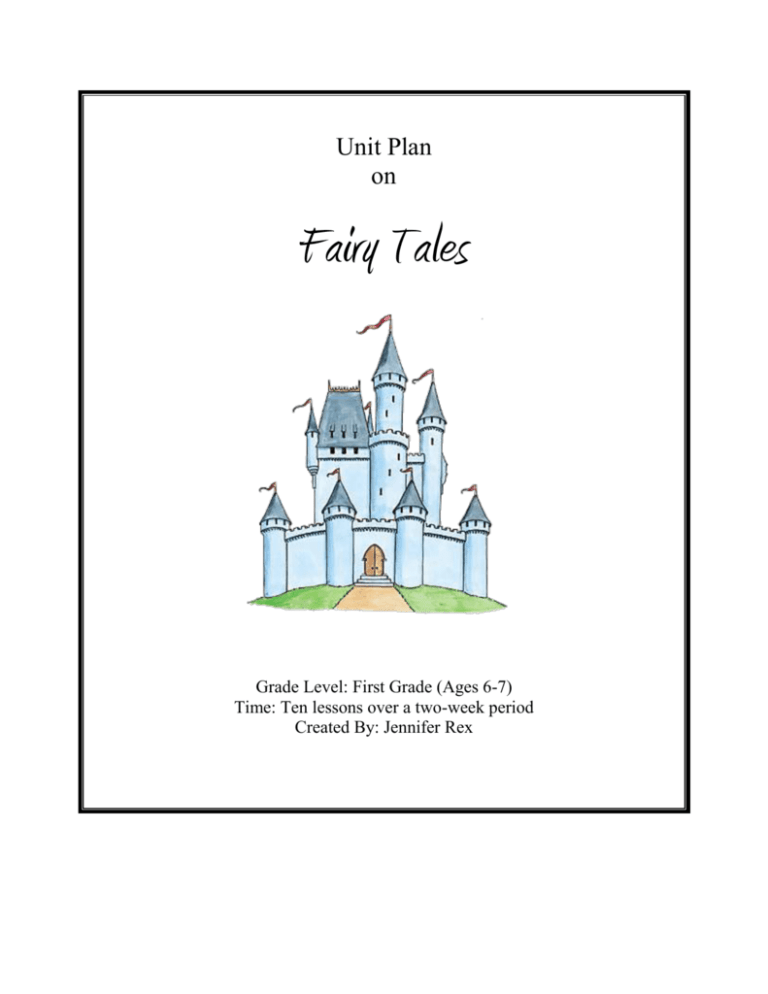
Unit Plan on Fairy Tales Grade Level: First Grade (Ages 6-7) Time: Ten lessons over a two-week period Created By: Jennifer Rex Contents Unit Rationale Pre-Unit Assessment KWL Chart Standards Addressed in the Unit Unit Objectives Two-Week Overview Grid Lesson 1: Fairy tales have good characters and bad characters Lesson 2: Fairy tales include objects, people, or events in 3s and 7s Lesson 3: Fairy tales usually have magic Lesson 4: Fairy tales have a problem or conflict that needs to be solved Lesson 5: Fairy tales have happy endings that usually resolve the problem Lesson 6: Fairy tales exist in many cultures Lesson 7: Point of view Lesson 8: Fairy tales include royalty Lesson 9: Fairy tale elements wrap-up Lesson 10: Fairy tale finale Appendix Post-Unit Assessment o Post-Unit Assessment KWL Chart o KWL Chart Rubric Unit Rationale Fairy tales are a part of our culture. Disney has brought Cinderella, Sleeping Beauty, and other fairy tale characters to the big screen and into the homes of many children. Many first graders, however, do not recognize these stories as fairy tales. The purpose of this unit is to help students recognize the common elements of fairy tales and to help them distinguish fairy tales from other genres. As part of this unit, students will be introduced to a variety of fairy tales, including those from other cultures and fractured fairy tales. Students will practice identifying literary elements in the tales, including characters and setting, and they will practice retelling plot by describing the beginning, middle, and end of fairy tales. For the culminating project, students will collaborate with peers to retell a fairy tale and to create an alternative ending to the traditional tale. Students will use digital tools to publish and share their fairy tale with their peers. The activities in the unit will help students develop their writing, reading, and computer skills. These critical skills can be applied in all subject areas. This unit consists of six lesson plans, and meets several of Virginia’s Standards of Learning (SOLs) in various subject areas as well as International Society of Technology in Education NETS and Performance Indicators for Students (ISTE NETS-S). All of the material presented in this unit is geared towards students in first grade. Pre-Unit Assessment A KWL chart will be given to each student as part of the pre-unit assessment. The students will complete the first two sections—what they already know about fairy tales and what they want to know about them. Students will not be graded on the pre-unit assessment. It is for information purposes only. The KWL chart is included in this unit plan. Name: ______________________________________________________ Date: ___________________ FAIRY TALES What I Know What I Want to Know What I Learned Jennifer Rex ED 554 Virginia Standards of Learning English 1.1b Tell and retell stories and events in logical order. 1.8 The student will read familiar stories, poems, and passages with fluency and expression. 1.9 The student will read and demonstrate comprehension of a variety of fiction and nonfiction. f) Identify characters, setting, and important events. g) Retell stories and events, using beginning, middle, and end. 1.12 The student will write to communicate ideas. a) Generate ideas. d) Use complete sentences in final copies. e) Begin each sentence with a capital letter and use ending punctuation in final copies. f) Use correct spelling for high-frequency sight words and phonetically regular words in final copies. g) Share writing with others. h) Use available technology. Visual Arts 1.4 The student will create works of art inspired by stories, poems, and themes. Math 1.12 The student will use nonstandard units to measure length and weight. Science 1.7 The student will investigate and understand the relationship of seasonal change and weather to the activities and life processes of plants and animals. Key concepts include how temperature, light, and precipitation bring about changes in a) plants (growth, budding, falling leaves, and wilting); Social Studies 1.4 The student will develop map skills by b) using cardinal directions on maps; c) identifying the shapes of the United States and Virginia on maps and globes; NETS-S 1.a, 1.b, 2.a, 2.b, 2.d, 4.b, 5.a, 5.b, 5.c, 6.a, 6.b, 6.c, 6.d Unit Objectives Students will identify good characters and bad characters in a fairy tale in a character mobile. Students will investigate weight as they measure the weight of various objects in the classroom and classify the objects as heavy, medium, or light weight. Students will determine the effect of light on plants from planting and examining their own beans. Students will identify the problem in a fairy tale during a dramatization of “The Three Billy Goats Gruff” Students will compare “Cinderella” to other versions of the same tale from around the world. Students will compare and contrast one fairy tale told from two different perspectives. Students will demonstrate their ability to work in cooperative groups by retelling in writing the beginning and middle of “The Three Little Pigs” and illustrating their work. Students will create and write a new ending to “The Three Little Pigs” in cooperative groups. Students will also produce illustrations to coincide with their writing. Students will create a digital story using available technology to import images and record audio. Students will demonstrate public speaking skills by presenting their digital stories to their peers. Students will be able to state elements of a fairy tale through completion of a class Fairy Tale Elements chart and answers provided in a post-assessment. Week 1 Topic Day 1: Monday Pre-assessment. Introduction to Fairy tales. Fairy tales have good characters and bad characters. Day 2: Tuesday Fairytales include objects, people, or events in 3s and 7s. Science Math Language Arts Measure weight and classify objects in the classroom as light, medium, or heavy. Day 3: Wednesday Fairy tales usually have magic. Listen to “The Three Little Pigs” Literature Book “The Three Little Pigs” Day 5: Friday Fairy tales have happy endings that usually resolve the problem. Plant beans and experiment with light/no light. Measure bean growth each day for the next few weeks. Character Mobile (I Like.., I am…, I can…, I am…) Technology Social Studies Art/Music Photo Story Project Day 4: Thursday Fairytales have a problem or conflict that needs to be solved. Act it out in groups (Reader’s Theater). “The Three Bears” “Jack and the Beanstalk” “The Three Billy Goats Gruff” Model with my photo story. Get into groups and assign roles. Retell in writing the beginning and middle and draw pictures. “The Little Red Hen” Week 2: Topic Day 6: Monday Fairy tales exist in many other cultures. Science Math Language Arts Technology Social Studies Day 7: Tuesday Point of View Venn Diagram (cut out words and put in venn diagram) Day 9: Thursday Day 10: Friday Fairy Tale Wrap- Fairy Tale Finale Up (march around to royal music with wands; eat fairy tale food e.g. princess punch, and share fairy tales)/ PostAssessment Review class Fairy Tale Elements Chart Listen to fairy tale at http://www.speak aboos.com/story/c inderella Compare Cinderella stories from around the world and locate those places on the map. (Comparison chart) Art/Music Photo Story Project Day 8: Wednesday Fairy tales include royalty (castles, dragons, princesses, etc.) Create story map for new ending (map maker will write). Start writing new Finish writing new ending (writer will write) and draw pictures to go along with it (illustrators Dress the emperor/princess. Introduce Photo Story. Import scanned pictures in group folder. Record audio as a group (read what wrote) with parent helper/wrap-up Share with class. ending (writer will write). Literature Book “Cinderella” Other stories (e.g., “The Korean Cinderella” by Shirley Climo or “Yeh-Shen: A Cinderella Story from China” by Ai-Ling Louie) will draw).(PM – teacher will scan in drawings and put in appropriate folders) “Little Red Riding Hood” and The Wolf’s Story: What Really Happened to Little Red Riding Hood by Toby Forward “Princess and the Pea” and “The Emperor’s New Clothes” Alternate Endings to Fairy Tales: A Photo Story Project Lesson Plan Teacher will have read and discussed “The Three Little Pigs” with the students previously (Day 1), so students will already be familiar with the fairy tale. It is assumed that the classroom has six available computers for groups of students to use during the school day. Each computer has access to the Internet, Photo Story, Microsoft Word, and Pixie (optional). Day 5: Objective: Students will demonstrate their ability to work in cooperative groups by retelling in writing the beginning and middle of “The Three Little Pigs” and illustrating their work. Procedure: 1. Teacher will read “The Little Red Hen”. 2. As a class, the students will complete the class Fairy Tale Elements Chart for that particular fairy tale. 3. Teacher and students will discuss whether “The Little Red Hen” had a happy or sad ending. Teacher and students will discuss happy endings in the fairy tales read so far. Teacher will ask the students to summarize the ending to “The Three Little Pigs” to recall prior knowledge. 4. Students will watch the model digital story of the “Three Little Pigs” that has an alternate ending. They will discuss the differences in the two endings. 5. Teacher will explain that the class is going to work in groups (of four students) and that each group will create a digital story of “The Three Little Pigs”. Teacher will emphasize that students cannot use the ending that was seen in the model Photo Story project. 6. Students will be divided into groups. (Note that in a Kagan classroom, students will already be grouped and appropriately). Students will be assigned roles that they will have for the duration of the project (Map Maker, Writer, Illustrator 1, Illustrator 2). 7. Students and Teacher will review how to work cooperatively in groups. 8. Students will re-tell in writing, the beginning and middle of “The Three Little Pigs”. (Note that students will stop writing when the wolf gets to the third pig’s house. That is when they will start creating a new ending on a subsequent day). Although all group members have input, the Writer’s job is to write. 9. Students draw pictures that coincide with what is being written. At least one picture needs to represent the beginning of the story and at least one picture needs to represent the middle of the story. Although all group members have input, the Illustrator’s will draw the pictures. 10. Students will complete the self-assessment individually. Evaluation: Self-assessment rubric completed by each student: Name:_______________________________________ Directions: Color the boxes that describe how you did today. Write one or two sentences that describe how your group worked together today. My Help I helped think of three things to write. I helped think of two things to write. I helped think of zero or one thing to write. My Job I did great at my job today. I did a good job today. I did not do my job I could probably do today. I will try better better next time next time. though. Group Reflection: Did you like working in your group? Did your group have any problems? What could you do better next time to help your group? ______________________________________________________________________________ ______________________________________________________________________________ Resources: “Little Red Hen” Fairy Tale Elements Chart (used throughout the unit) “The Three Little Pigs” Photo Story (http://jrex2.wordpress.com/artifacts/ and student examples at http://wewrotethesestories.blogspot.com/) Self-Assessment (one for each student) “The Three Little Pigs” sequencing cards Necklaces or Placecards for each job (optional) Lined paper for each group Blank paper for each group Crayons/markers for each group OR access to Pixie Accommodations: Students Below Grade Level will receive sequence cards that coordinate with “The Three Little Pigs”. They will put the cards in the correct order before beginning the retell. Students Above Grade Level will be assigned an additional role of Checker, and will assist other group members. ELL students, as well as all students, will benefit from working in groups. They will be able to use their native-language dictionary, as needed, to ensure comprehension of key terminology. Day 6: Objectives: Students will compare “Cinderella” to other versions of the same tale from around the world Students will create and write a new ending to “The Three Little Pigs” in cooperative groups. Procedure: 1. 2. 3. 4. 5. 6. 7. 8. 9. During Buddy Reading, pairs of students will read different Cinderella stories from around the world. Students will watch/read the Cinderella story via http://www.speakaboos.com/story/cinderella. As a class, the students will complete the class Fairy Tale Elements Chart for that particular fairy tale. Students will pair-up share-up to discuss how the Cinderella fairy tale compared to the version from a different country that they read. Pairs will share with whole class one difference or similarity between the two tales, as well as identify on a classroom map the location of the country that the other version originated from. Students will be seated in their groups (if not already). Students will brainstorm together how their own version of “The Three Little Pigs” will end. Every group member should share at least one idea. The groups must work together to select an ending or combine ideas into one ending. Students will be given copies of the Story Map and will work in their groups to complete the story map (Map Maker will write). Students will use their Story Map and begin writing the new altered ending to the fairy tale (Writer will write). Teacher will inform students that they will have more time tomorrow to finish writing their ending. Evaluation: Teacher observations of discussions during the pair-up, share-up time. Story Map Self-Assessment/Rubric: Name:_______________________________________ Directions: Color the two boxes that describe how you did today. Write one or two sentences that describe how your group worked together today. Story Map My Help 5 or 6 sections are 3 or 4 sections are completed. completed. I gave three ideas I gave two ideas to my group. to my group. 1 or 2 sections are completed. I gave one idea to my group. Group Reflection: Did you like working in your group? Did your group have any problems? What could you do better next time to help your group? ______________________________________________________________________________ ______________________________________________________________________________ ______________________________________________________________________________ Resources: Story Map (one for each group, see Appendix) Self-Assessment (one for each student) Computer with access to Internet (or teacher can read hard copy of “Cinderella”) Copies of other versions of “Cinderella” from around the world. Writing paper (for each group) Accommodations: Students Below Grade Level and ELL students will benefit from working with peers in the pair-up, share-up activity as well as the group work. They will also benefit from watching the fairy tale online that has pictures and text to follow along with the story. Students Above Grade Level will complete a comparison chart while watching the Cinderella online version. Day 7: Objectives: Students will compare and contrast one fairy tale told from two different perspectives. Students will create and write a new ending to “The Three Little Pigs” in cooperative groups. Students will also produce illustrations to coincide with their writing. Procedure: 1. Teacher will read “Little Red Riding Hood” and “The Wolf’s Story: What Really Happened to Little Red Riding Hood”. They will discuss point of view. 2. Students will complete a venn diagram to decide which events, settings, and characters were in one or both fairy tales. 3. Whole class will complete the Fairy Tale Elements Chart for “Little Red Riding Hood”. 4. Students will be seated with project groups (if not already). 5. Groups will type their new endings to “The Three Little Pigs” into a Word document. They will have done this throughout the year so they will not need instruction on how to do that. Groups will also finish illustrating their endings (Illustrators will draw). 6. Students will be told that tomorrow they will use Photo Story to start putting their digital story together. Later that day, teacher will scan all drawings as JPEG images and place them in a folder. Each group will have an electronic folder to keep all of their work. Evaluation: Venn diagrams. Venn diagram rubric: Venn Diagram 9 to 12 words are placed correctly. 6 to 8 words are placed correctly. 5 or fewer words are placed correctly. Resources: Venn diagram “Little Red Riding Hood” “The Wolf’s Story: What Really Happened to Little Red Riding Hood” Writing paper and coloring paper (for each group) Crayons or markers (for each group) OR access to Pixie. Class Fairy Tale Elements chart Accommodations: Students Below Grade Level will work with the teacher in a small group to complete the venn diagram. Students Above Grade Level will write some of the similarities and differences between the two fairy tales on the back side of their venn diagrams. ELL Students can work in pairs or in the small group with the teacher to complete the venn diagram. Pictures, in addition to the words, can be sorted. Day 8:. Objective: Students will create a digital story using available technology to import images. Procedure: 1. Teacher will read “Princess and the Pea” and “The Emperor’s New Clothes”. 2. As a class, the students will complete the class Fairy Tale Elements Chart for one or both fairy tales. 3. Students and teacher will discuss that fairy tales include royalty (dragons, castles, princesses, kings, etc.). To help solidify the concept of royalty, as the class talks about one type of royalty they’ve seen in a fairy tale, the class will act it out (e.g., roam the classroom as dragons). 4. Students will be given paper cut-outs of a girl or boy as well as art supplies. They are to dress the princess from “The Princess and the Pea” or the emperor from “The Emperor’s New Clothes”. 5. Students will be seated in their own seats. Teacher will introduce Photo Story to the students (through a projector). Teacher will walk through the steps, pointing out key features and functions. Teacher will demonstrate how to add pictures and type text into the appropriate fields. 6. Students will be directed to sit with their project groups at a computer. Students will upload their images from their electronic work folder into Photo Story and will arrange them in the order they desire. Students will be instructed that each group member must upload at least one image. 7. Students will open their Word document with their completed text. Students will copy and paste their text into the appropriate fields in Photo Story. Students will be instructed that each group member copies and pastes into at least one field. 8. Teacher will tell students that they will be adding their own voice recordings tomorrow. Evaluation: Anecdotal notes regarding group participation and individual participation Observations during class discussion Photo Story Self-Assessment: Name:_______________________________________ Directions: Color the two boxes that describe how you did today. Write one or two sentences that describe how your group worked together today. Photo Story – I uploaded one Images and Text image and one piece of text. I uploaded two images and more than two pieces of text. I uploaded three or more images and three or more pieces of text. Collaboration I tried my best in my group today. I will try harder to work better with my group tomorrow. I did not work very well in my group today but I will try to tomorrow. Group Reflection: Did you like working in your group? Did your group have any problems? What could you do better next time to help your group? ______________________________________________________________________________ ______________________________________________________________________________ ______________________________________________________________________________ Resources: Princess and the Pea” “The Emperor’s New Clothes” Paper figures (girl and boy), one for each student Art supplies Computers with Photo Story and Word Images and text placed in group digital folders Accommodations: Below Grade Level students will be able to upload images that the teacher provides. They will be able to copy and paste text that the teacher has already written and provided in the electronic folder. Above Grade Level students will upload their own created images. They will upload more than three pictures (one for beginning, one for middle, and one for ending). They will copy and paste text that they have written and typed themselves into Word. ELL students can copy and paste text that the teacher has already written and provided in the electronic folder. Day 9: Objectives: Students will be able to state elements of a fairy tale through completion of a class Fairy Tale Elements chart and answers provided in a post-assessment. Students will create a digital story using available technology to record audio. Procedure: 1. Teacher and students will briefly review the class Fairy Tale Elements chart and discuss some of the favorite fairy tales that they have read during the past two weeks. 2. Teacher will model to whole class how to record audio into Photo Story. Teacher will emphasize the need to read slowly, clearly, and loudly. Teacher will model and students will practice with a sentence or two. Teacher will explain that the parent volunteers will help them record their voices. 3. Students will be provided with a blank Fairy Tale Elements chart and will complete it. 4. While the class is completing the fairy tale chart (and completing any unfinished assignments from the unit), project groups will be pulled one at a time by at least one parent-volunteer. The parent volunteers will assist students in recording their voices into Photo Story. 5. Teacher will remind students that they will share their published fairy tales during the Fairy Tale Finale tomorrow. Evaluation: Fairy Tale Elements Chart Fairy Tale Elements Chart Rubric: Fairy Tale Elements Chart Three-fourths or more of the chart is completed accurately. One-half of the chart is completed accurately. Less than one-half of the chart is completed accurately. Parent-volunteer feedback regarding group audio recordings. Resources: Fairy Tale Elements Chart, one for each student (see Appendix) Computers with Photo Story Headphone/microphone set, at least one Parent volunteers, at least one Accommodations: Below Grade Level students will read text that was provided by the teacher. These students will complete the fairy tale elements chart in pairs or small group with the teacher. Above Grade Level students will read text that they wrote. These students will add another row to the fairy tale elements chart. ELL students who struggle with speaking English (as well as shy students), will not need to record their voices into Photo Story if they do not feel comfortable. They can read their parts to the teacher in private or in a small group setting. ELL students will work in pairs to complete the fairy tale elements chart and can use their native language dictionary, as needed. Day 10: Objective: Students will demonstrate public speaking skills by presenting their digital stories to their peers. Procedure: 1. Students will participate in a royal march around the classroom, waving wands and/or other fairy tale props. Royal music will be played during the march/dance. 2. Students will choose some fairy tale treats (e.g., princess punch), as desired. All food and drink will be peanut-free and parents will have been made aware of the activity. 3. Students will be seated at their own desks. Teacher will remind the class about proper etiquette and respect required during group presentations. 4. Project groups will take turns introducing and sharing their fairy tales in front of the whole class. Groups will lead a short question/answer/comment discussion after their fairy tale is viewed. 5. Students will clean up desk areas and take unit post-assessment. Later that day, teacher will post digital fairy tales to the classroom blog so parents can view and comment. Evaluation: Photo Story Project Photo Story Project Rubric: Name:____________________________________________ Alternate Ending in Photo Story Rubric 3 Retell Beginning and Middle are retold accurately. Writing/Editing Word wall words are spelled correctly. Sentences begin capital letters. Sentences end in correct punctuation. Pictures 3 or more pictures are included. Collaboration Received a score of 4 or 5 by group members. 2 Beginning or Middle is re-told accurately. Some word wall words are spelled correctly. Some sentences begin with capital letters. Some sentences end in correct Punctuation. 2 pictures are included. Received a score of 2 or 3 by group members. 1 No parts are retold accurately. Few word wall words are spelled correctly. Few sentences begin with capital letters. Few sentences end in correct punctuation. 0 or 1 picture is included. Received a score of 1 or 2 by group members. Resources: Computer/projector with students’ digital stories Post-assessment, one for each student Accommodations: ELL students who struggle with speaking English (as well as shy students), will not need to speak in front of the whole class if they do not feel comfortable. They can present their fairy tales in writing or orally to the teacher in private or in a small group setting. APPENDIX UNIT RESOURCES “Little Red Riding Hood” BOTH “The Wolf’s Story: What Really Happened to Little Red Riding Hood” Other Resources: http://www.sparklebox.co.uk/cll/fairy/pigs.html The Three Billy Goats Gruff Reader’s Theater Script (Characters: Storyteller 1, Storyteller 2, Troll, BG 1, BG 2, and BG 3) Storyteller 1: Once upon a time there were three billy-goats who wanted to go up to the hillside to make themselves fat. The name of all three was "Gruff.” Storyteller 2: On the way up was a bridge. And under the bridge lived a great ugly Troll, with eyes as big as saucers and a nose as long as a poker. Storyteller 1: The littlest billy-goat Gruff was the first to cross the bridge. All: TRIP, TRAP! TRIP, TRAP! Troll: WHO'S THAT tripping over my bridge? BG#1: Oh, it's only I, the tiniest billy-goat Gruff. I'm going up the hillside to make myself fat. Troll: Now I'm coming to gobble you up! BG#1: Oh no! Please don't take me. I'm too little, that I am. Wait for the second billygoat Gruff. He's much bigger. Troll: Very well, be off with you! Storyteller 2: A little while after came the second billy-goat Gruff across the bridge. All: TRIP, TRAP! TRIP, TRAP! TRIP, TRAP! Troll: WHO'S THAT tripping over my bridge? BG#2: Oh, it's the second billy-goat Gruff. I'm going up to the hillside to make myself fat. Troll: Now I'm coming to gobble you up! BG#2: Oh no! Don't take me. Wait for the third billy-goat Gruff. He's much bigger, that he is! Troll: Very well, be off with you! Storyteller 1: Just then came the third billy-goat Gruff. All: TRIP, TRAP! TRIP, TRAP! TRIP, TRAP! Troll: WHO'S THAT tripping over my bridge? BG#3: IT IS I! THE THIRD BILLY-GOAT GRUFF. T: Now I'm coming to gobble you up! BG#3: Well, come along! I’m big and strong and I can push you over this bridge. Storyteller 2: That was what the big billy-goat said. And that was what the big billygoat did. Storyteller 1: And after that he went up the hillside. There, the three billy-goats got so fat they could hardly walk home again. All: And they all lived happily ever after. Adapted from www.readinglady.com Post-Unit Assessment The same KWL chart that the students received as a pre-unit assessment will be returned to each student to complete as a post-unit assessment. The students will be able to review their responses before the unit began—what they already knew about fairy tales and what they wanted to learn. In the post-unit assessment, students will complete the final section—what they learned about fairy tales during the unit. Students will be graded on the post-unit assessment. A rubric for grading the post-unit KWL is included in this unit plan. Name: ______________________________________________________ Date: ___________________ FAIRY TALES What I Know What I Want to Know What I Learned Post-Unit KWL Rubric 10 Five or more correct items are listed in the Learned section. 8 Four correct items are listed in the Learned section. 6 Three correct items are listed in the Learned section. 4 Two correct items are listed in the Learned section. 2 One correct item is listed in the Learned section. 0 Zero correct items are listed in the Learned section.


